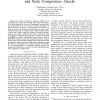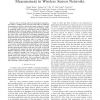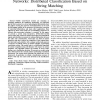TCS
2012
13 years 28 days ago
2012
In Sensor Networks, the lack of topology information and the availability of only one communication channel has led research work to the use of randomization to deal with collisio...
COMSUR
2011
13 years 5 months ago
2011
Sensor networks with battery-powered nodes can seldom simultaneously meet the design goals of lifetime, cost, sensing reliability and sensing and transmission coverage. Energy-har...
INFOCOM
2011
IEEE
13 years 8 months ago
2011
IEEE
—For energy conservation, a wireless sensor network is usually designed to work in a low-duty-cycle mode, in which a sensor node keeps active for a small percentage of time durin...
INFOCOM
2011
IEEE
13 years 8 months ago
2011
IEEE
—In a sensor network, an important problem is to provide privacy to the event detecting sensor node and integrity to the data gathered by the node. Compromised source privacy can...
INFOCOM
2011
IEEE
13 years 8 months ago
2011
IEEE
Abstract—Due to its large scale and constrained communication radius, a wireless sensor network mostly relies on multi-hop transmissions to deliver a data packet along a sequence...
IS
2011
13 years 9 months ago
2011
Sensor networks are often used to perform monitoring tasks, such as animal and vehicle tracking, or the surveillance of enemy forces in military applications. In this paper we int...
TITB
2010
14 years 3 days ago
2010
Mobile sensor-based systems are emerging as promising platforms for healthcare monitoring. An important goal of these systems is to extract physiological information about the subj...
COMCOM
2007
14 years 5 months ago
2007
Enterprises that may rely on critical equipments which are constantly moving around, for example, hospitals – need to ensure they can know the current location of vital but mobi...
CORR
2008
Springer
14 years 5 months ago
2008
Springer
We study a sensor node with an energy harvesting source. The generated energy can be stored in a buffer. The sensor node periodically senses a random field and generates a packet....
CORR
2008
Springer
14 years 5 months ago
2008
Springer
Energy consumption is the most important factor that determines sensor node lifetime. The optimization of wireless sensor network lifetime targets not only the reduction of energy...





